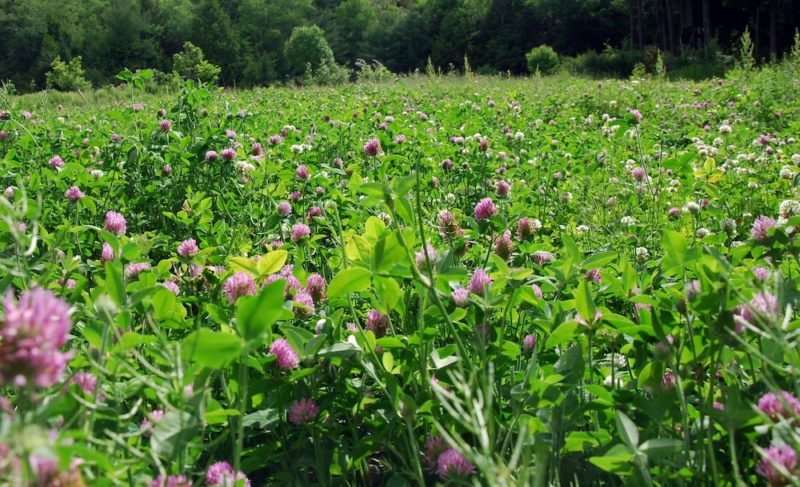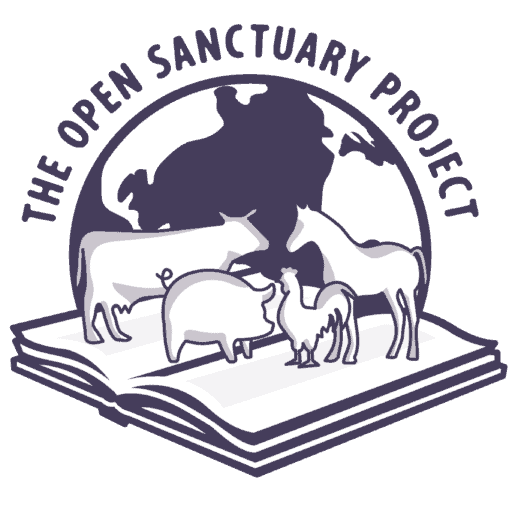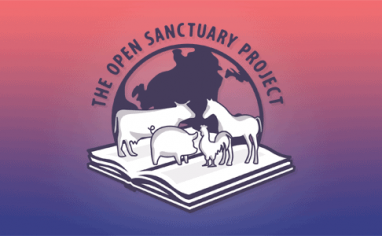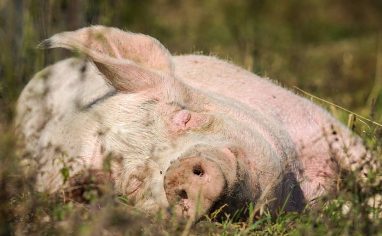

Veterinary Review Initiative
The information in this resource was reviewed for accuracy and clarity by a qualified Doctor of Veterinary Medicine with farmed animalA species or specific breed of animal that is raised by humans for the use of their bodies or what comes from their bodies. care experience in September 2022 as part of the creation of Basic Sheep And Goat Care Part 2. While the course focuses on sheep and goats, the following information also applies to cowsWhile "cows" can be defined to refer exclusively to female cattle, at The Open Sanctuary Project we refer to domesticated cattle of all ages and sexes as "cows.". Read about our Veterinary Review Initiative here!
Ruminant Digestion
In order to understand bloat, it’s helpful to have a basic understanding of ruminant digestion. If you haven’t already, we recommend checking out our overview here.
In ruminants, a significant amount of gas is produced during the digestive process and is naturally released through eructation (belching). Bloat occurs if this gas is not able to be released for some reason. The build-up of gas causes the rumen to expand, which will displace and put pressure on internal organs and can make it difficult for the individual to breathe. Bloat should be considered a health emergency and must be addressed immediately.
There are two types of bloat that can affect mature ruminants – frothy bloat (or primary ruminal tympany) and free-gas bloat (or secondary ruminal tympany). A third type of bloat, abomasal bloat, can affect young ruminants and is not covered in this resource. Though frothy bloat and free-gas bloat have different causes and require different responses, their signs are very similar. The most obvious sign of bloat is distention of the left side of the abdomen, though the individual’s entire abdomen may be enlarged. In some cases, the rumen may be so distended that their left side bulges above the level of the spine, creating a hump. The left side of their abdomen will feel tight and, when tapped, may produce a sound like a kettle drum. Bloated individuals often develop labored breathing and may be observed grunting, open-mouth breathing with their tongue out, and extending their neck. You may also see them biting or kicking at their abdomen. Frequent urination and signs of discomfort and distress are commonly seen, and as the condition progresses, individuals may become recumbent.
If not addressed, bloat can be fatal. Be sure to contact your veterinarian immediately if you suspect a resident is suffering from bloat. Depending on the severity, your veterinarian may instruct you to administer certain treatments immediately. If you can, encourage the individual to walk or at least remain standing while waiting for treatments to be administered.
Frothy Bloat
Frothy Bloat is the more common of the two types and occurs when a stable foam develops on top of the rumen liquid, preventing the gas from being released normally. This type of bloat is diet-related. Grazing on lush pastures containing large quantities of certain legumes (especially alfalfa and red and white clover) is one of the main causes of frothy bloat. Frothy bloat can also be caused by high-grain diets (which we do not recommend for a variety of reasons), especially if the grain is finely ground.
Frothy bloat caused by pasture is most likely to occur in the spring and fall. When pasture is the cause, multiple residents are typically affected. However, some individuals may be more prone to bloat than others, especially newer residents who may not be accustomed to lush pastures (which is why they should be slowly introduced to pastures). If a resident shows signs of bloat, it is important to immediately prevent them from further grazing until the underlying cause is confirmed. If the affected individual is not a new resident (and therefore, the bloat cannot be explained by them not yet being accustomed to available vegetation), it’s a good idea to remove all members of the group from pasture areas, even if not everyone is showing concerning signs.
Frothy bloat is treated with anti-foaming agents such as vegetable oil or products containing dioctyl sodium sulfosuccinate (DSS) or poloxalene. These can be drenched or administered via stomach tube (incorrect technique for either of these administration routes can have dire consequences, so proper training is a must). We recommend always having an antifoaming agent and necessary administration supplies on-hand in case of emergency. You should also work with your veterinarian to ensure you are properly trained to administer them. Unlike with free-gas bloat, placement of a stomach tube alone will not release gas build-up in individuals suffering from frothy bloat.
Prevention of frothy bloat is key. Avoid giving residents access to high-risk vegetation (such as pastures heavy in legumes). While some sanctuaries have had no issue with residents grazing on wet pastures, be aware that this does increase the risk of frothy bloat. Additionally, if residents are very hungry, they may gorge on pasture and develop frothy bloat. We recommend that ruminant residents have free-choice access to forages (unless your veterinarian recommends otherwise), so excessive hunger shouldn’t typically be an issue. In instances where residents have not had free-choice access to food, feed them hay before giving them access to pasture. If you must supplement a resident’s diet with grain, be sure to talk to your veterinarian about the safest way to do so, and avoid finely ground grains (including pelleted food made from finely ground grains).
Free-Gas Bloat
Free-gas bloat is much less common and can have a variety of causes. Anything that creates an obstruction or interferes with belching will result in the build-up of gas in the rumen. Potential causes include obstruction of the esophagus due to choking, lesions of the esophageal groove, or pressure from a mass or enlarged lymph node. Certain health conditions, such as grain overload or anaphylaxis, can cause secondary free-gas bloat. Individuals can also develop free-gas bloat if they become stuck in a position that prevents them from belching, such as staying in a laterally recumbent position (flat on their side) for extended periods of time or, worse, getting stuck on their back. There are various situations that might result in a resident getting stuck in a bloat-causing position, such as falling into a ditch, lying down on an incline that makes rising difficult, or being unable to rise due to injury or weakness. Free-gas bloat is also a concern when an individual is sedated for a medical procedure. Sedated individuals should be propped up to keep them in a sternal position (hay or straw bales can be used to do this), and they should be monitored closely to ensure they do not end up flat on their side.
Unlike frothy bloat, free-gas bloat typically only affects one individual rather than multiple members of the group. Removal of gas is imperative and is typically done with a stomach tube, though in some cases, your veterinarian may need to take more aggressive steps such as trocharization (inserting a trocar, cannula, or large-gauge needle into the rumen through the abdominal wall). After alleviating the gas, it’s important to investigate the underlying cause of the free-gas bloat.
Talk to your veterinarian about the emergency supplies you should have on hand to respond to both types of bloat. By having the right supplies available and a basic understanding of how to use them, you’ll be better prepared in the event that your veterinarian cannot make it to the sanctuary in time and instead must talk you through certain life-saving interventions.
SOURCES:
Bloat In Small Ruminants | University Of Arkansas At Pine Bluff
Sheep And Goat Medicine, Second Edition | D.G. Pugh And A.N. Baird (Non-Compassionate Source)
Bloat In Ruminants | Merck Veterinary Manual (Non-Compassionate Source)
Cattle Medicine | Phillip Scott, Colin D. Penny, and Alastair Macrae (Non-Compassionate Source)
Bloat In Cattle | The Cattle Site (Non-Compassionate Source)
Non-Compassionate Source?
If a source includes the (Non-Compassionate Source) tag, it means that we do not endorse that particular source’s views about animals, even if some of their insights are valuable from a care perspective. See a more detailed explanation here.






